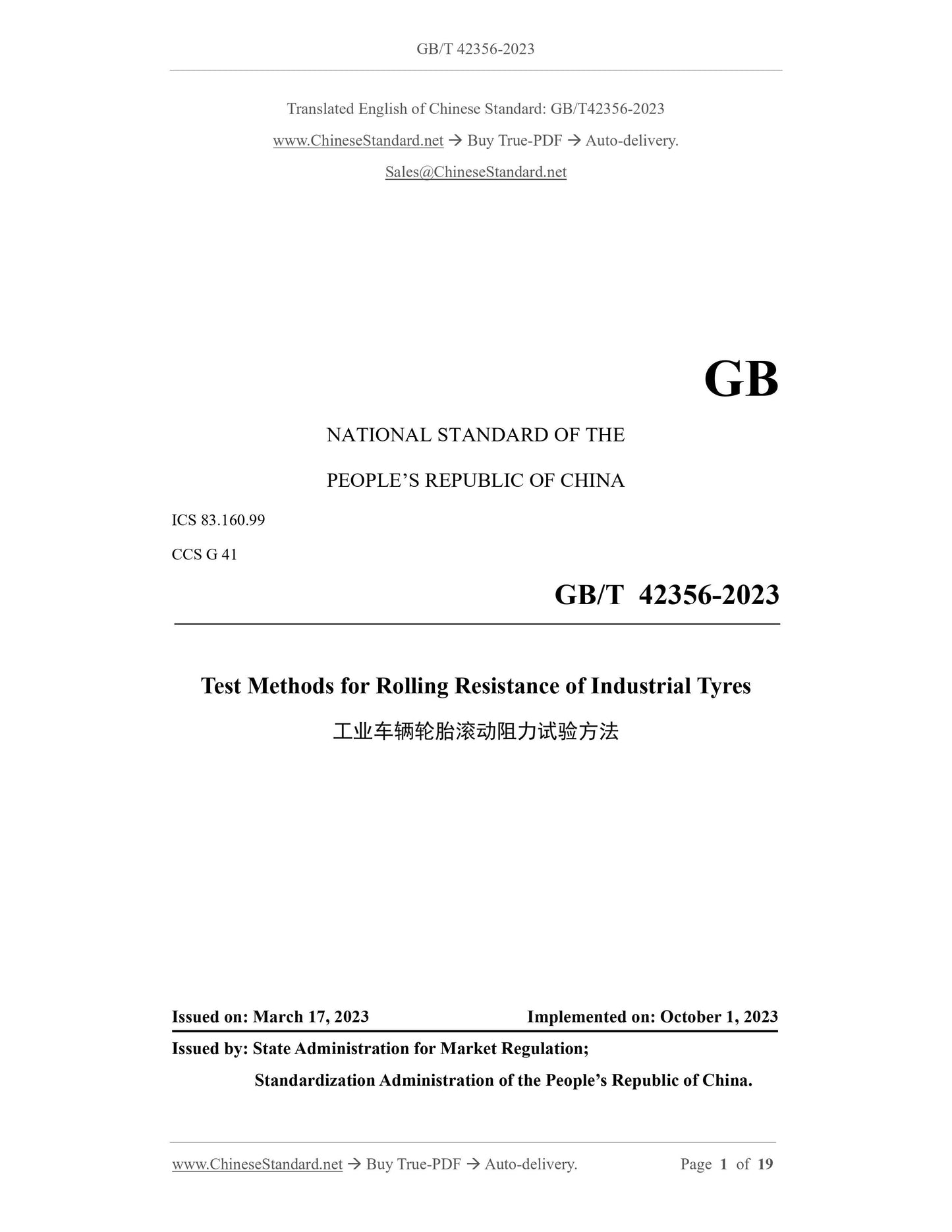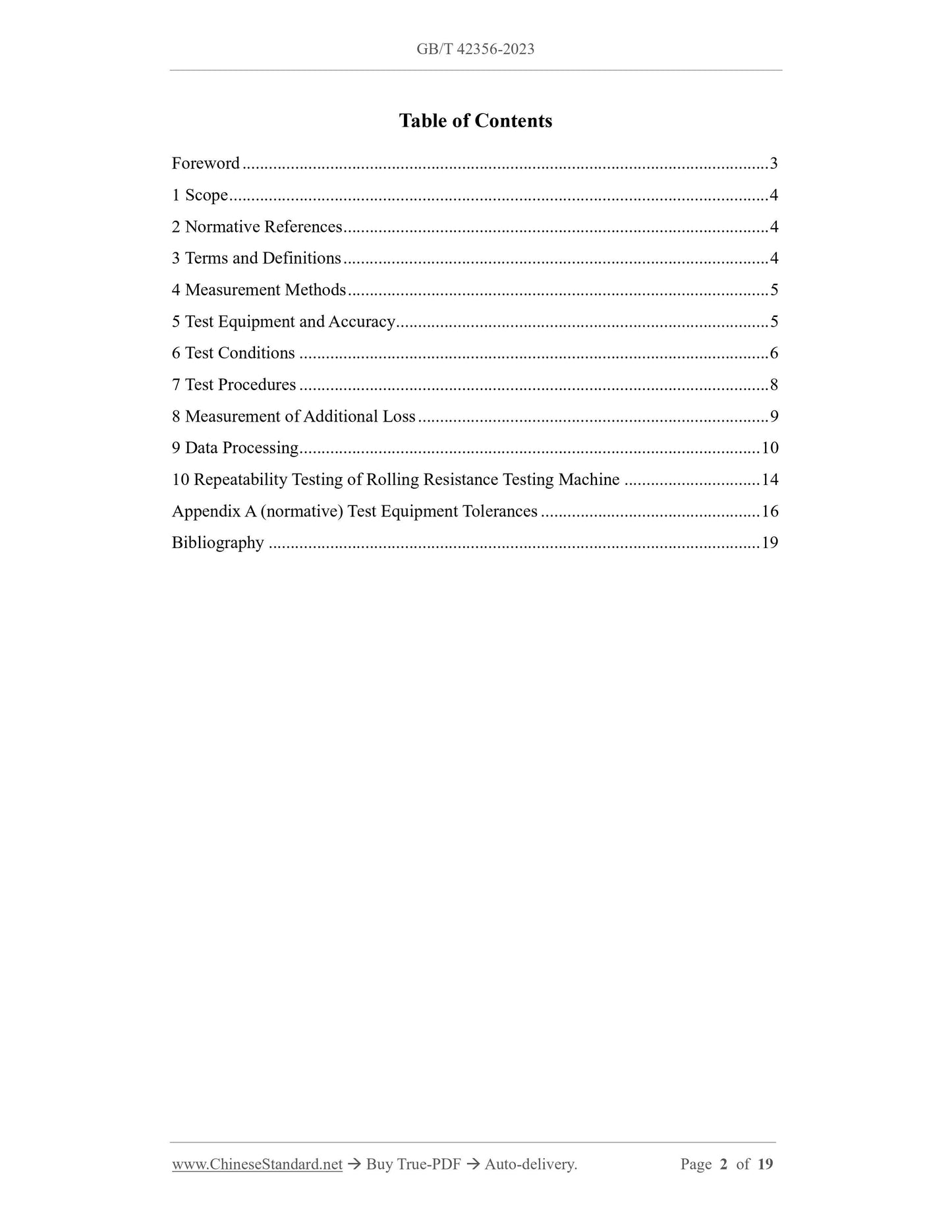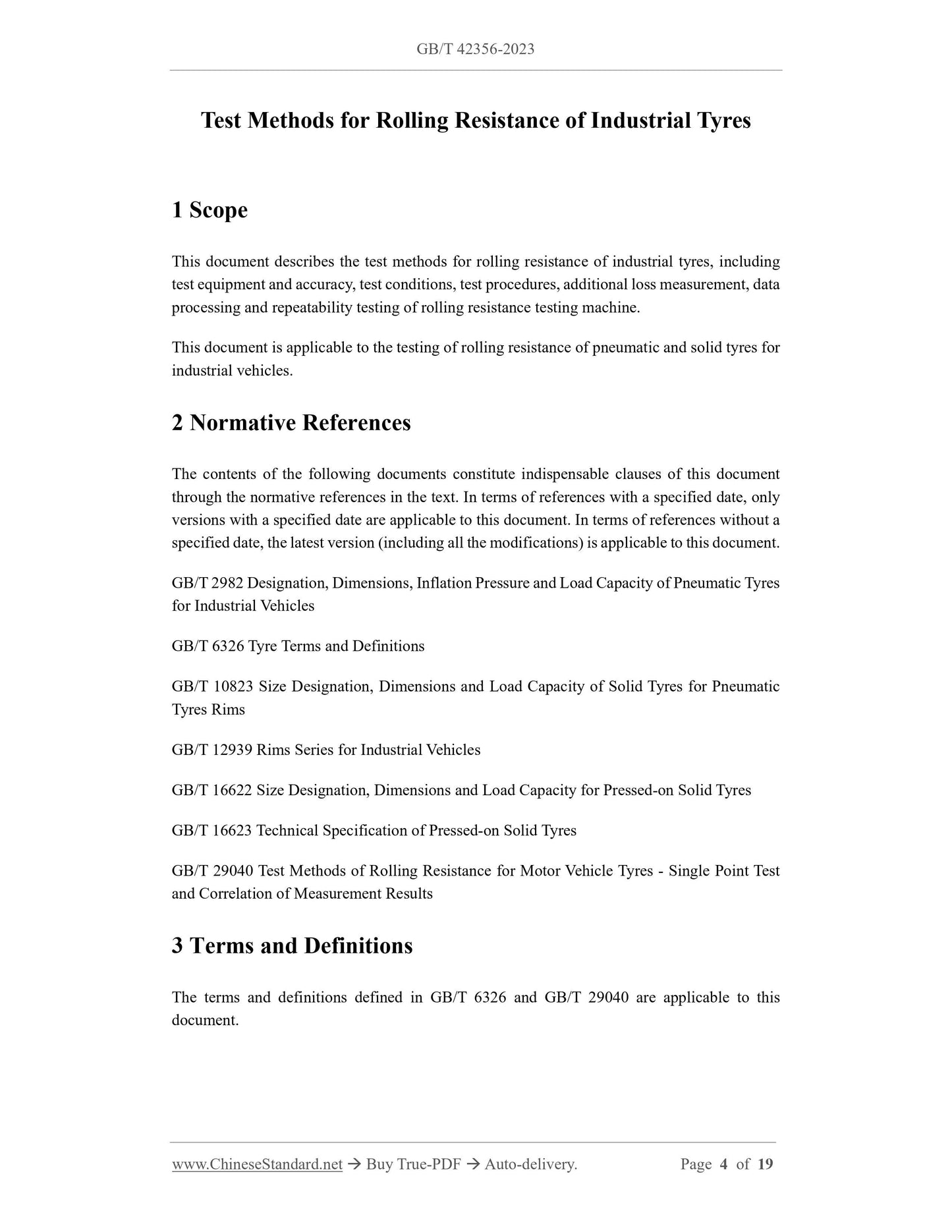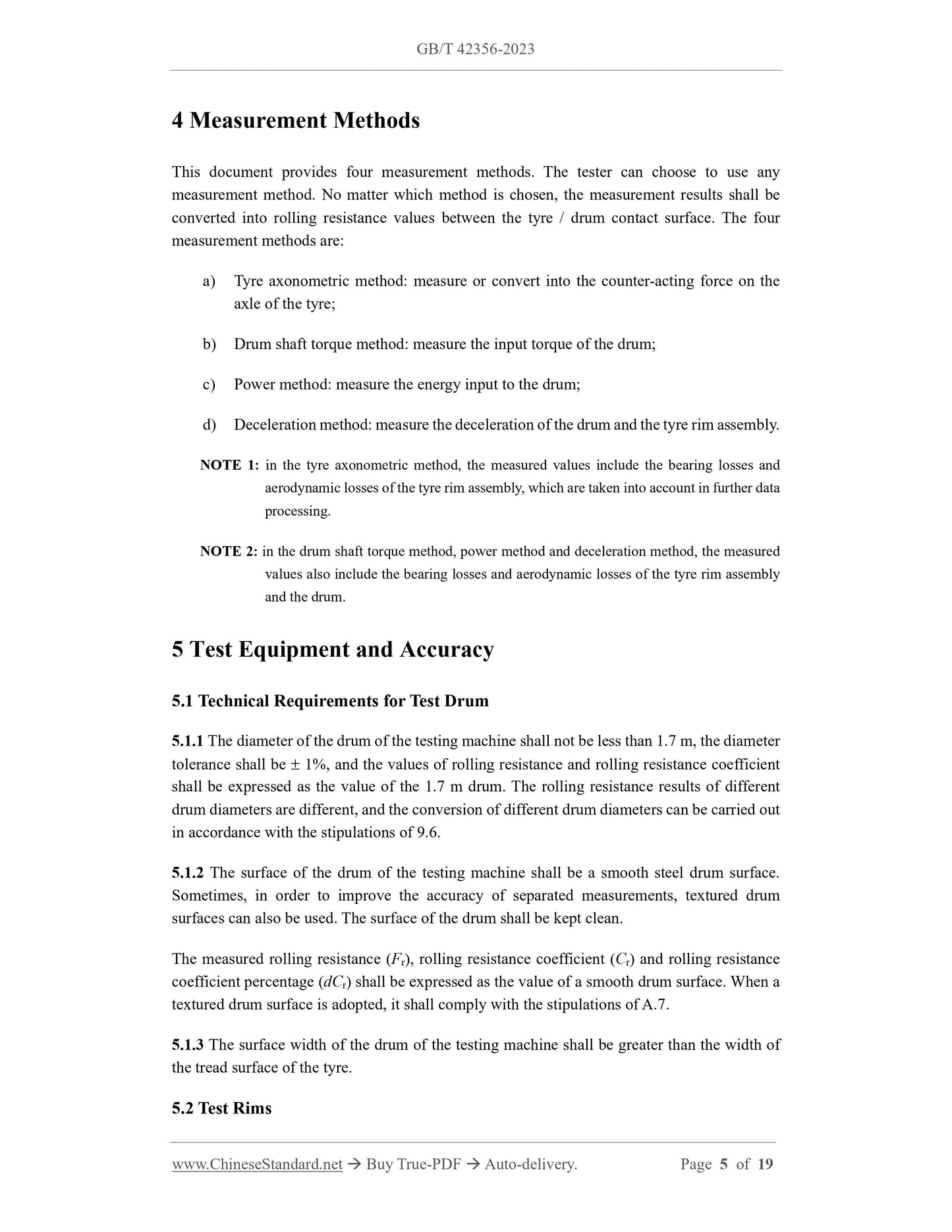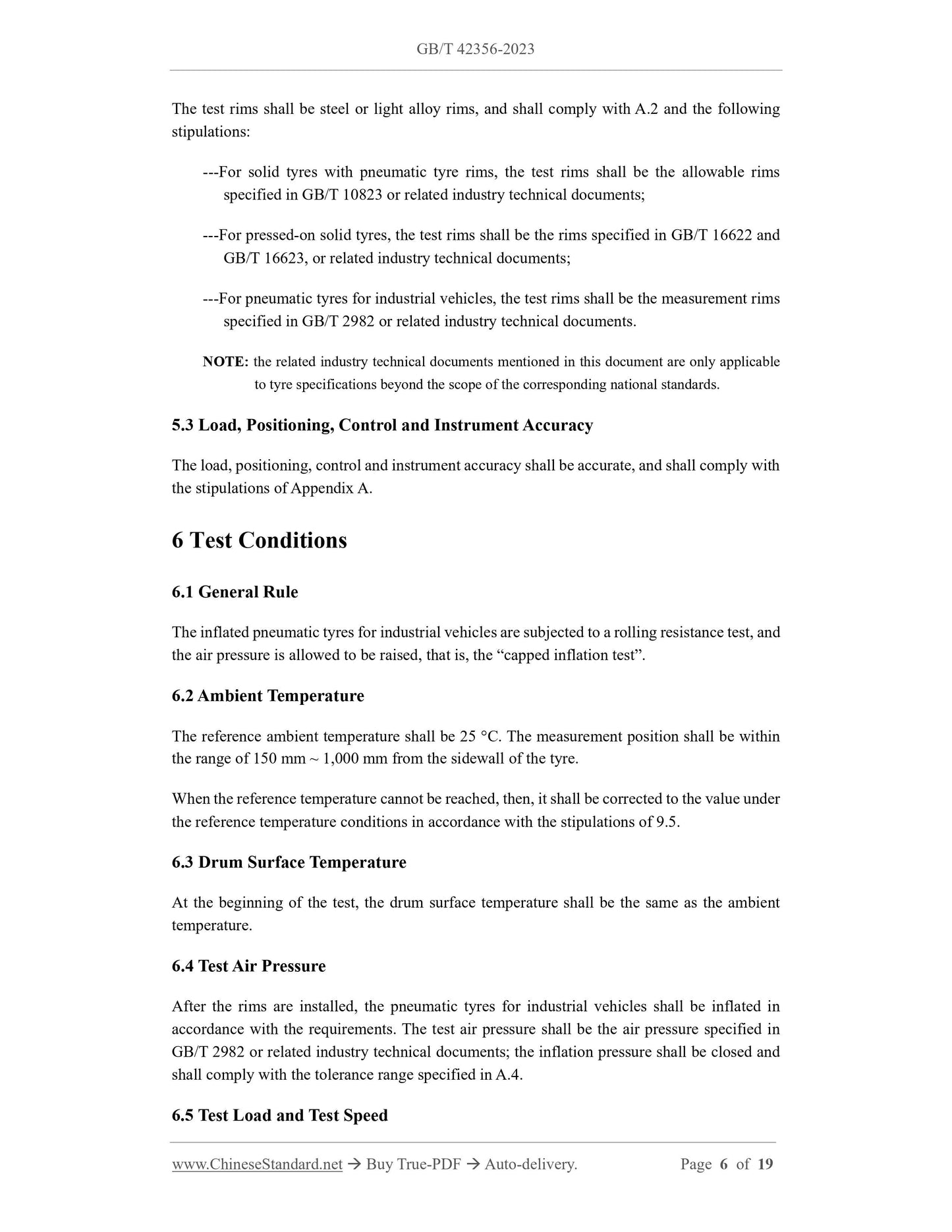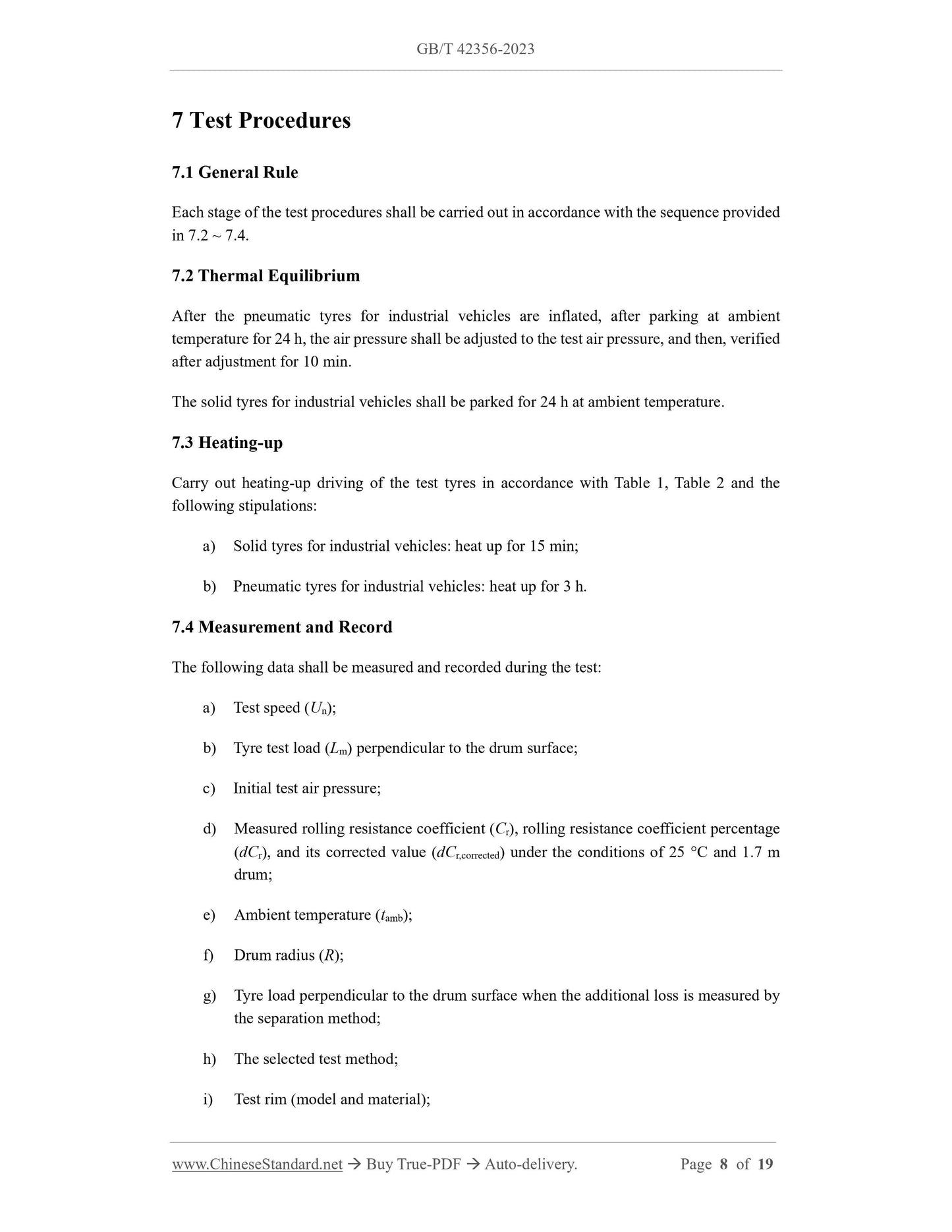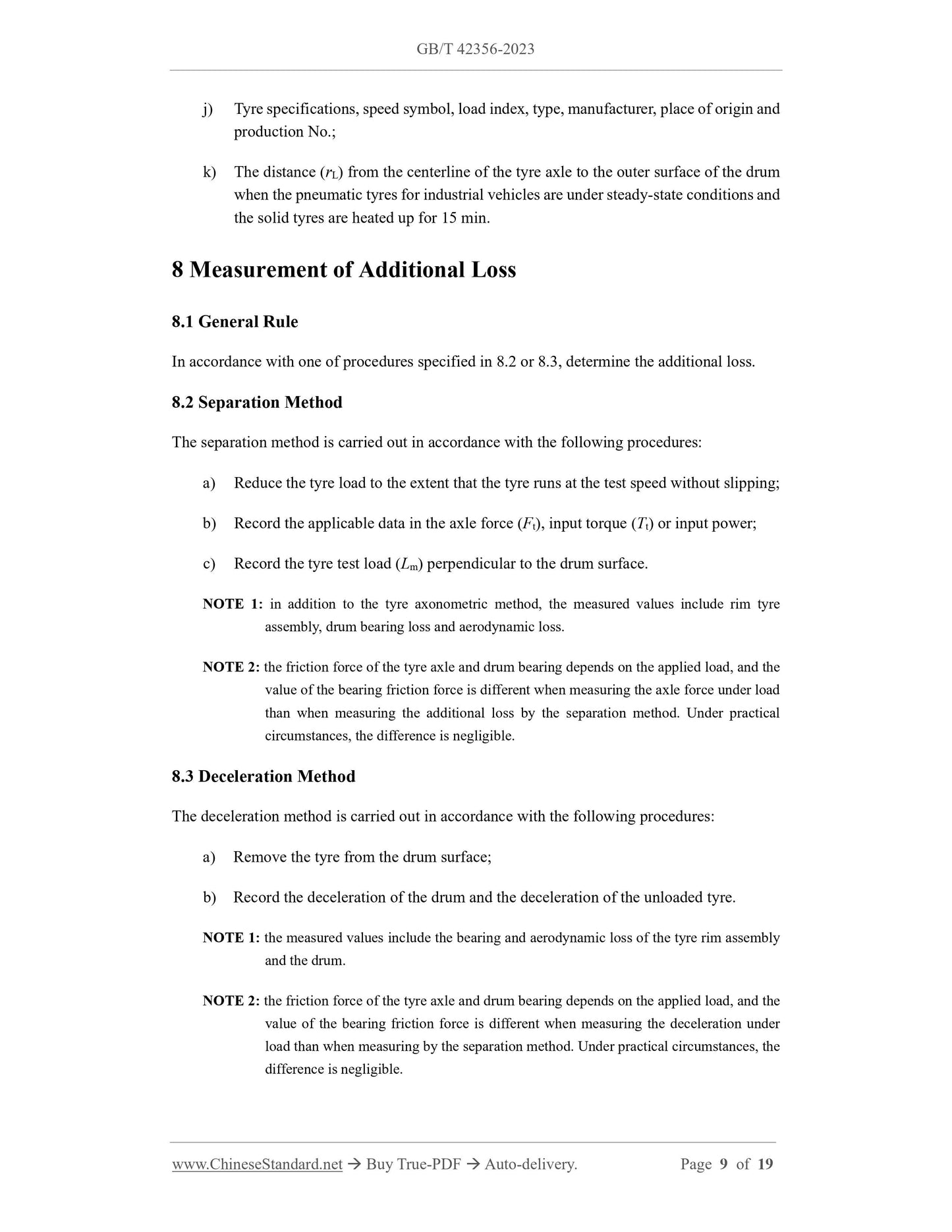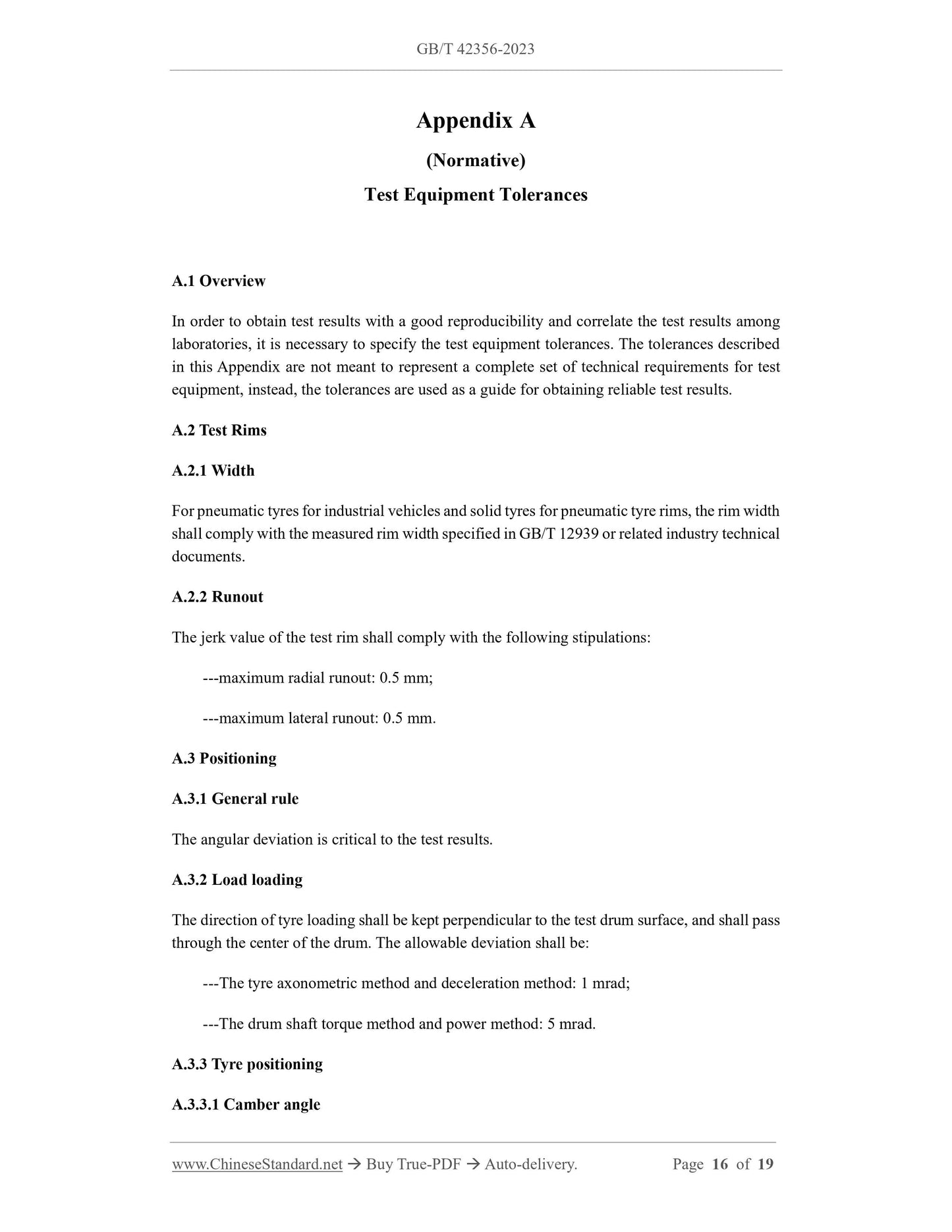1
/
of
8
PayPal, credit cards. Download editable-PDF and invoice in 1 second!
GB/T 42356-2023 English PDF (GBT42356-2023)
GB/T 42356-2023 English PDF (GBT42356-2023)
Regular price
$260.00 USD
Regular price
Sale price
$260.00 USD
Unit price
/
per
Shipping calculated at checkout.
Couldn't load pickup availability
Delivery: 3 seconds. Download true-PDF + Invoice.
Get QUOTATION in 1-minute: Click GB/T 42356-2023
Historical versions: GB/T 42356-2023
Preview True-PDF (Reload/Scroll if blank)
GB/T 42356-2023: Test methods for rolling resistance of industrial tyres
GB/T 42356-2023
GB
NATIONAL STANDARD OF THE
PEOPLE’S REPUBLIC OF CHINA
ICS 83.160.99
CCS G 41
Test Methods for Rolling Resistance of Industrial Tyres
ISSUED ON: MARCH 17, 2023
IMPLEMENTED ON: OCTOBER 1, 2023
Issued by: State Administration for Market Regulation;
Standardization Administration of the People’s Republic of China.
Table of Contents
Foreword ... 3
1 Scope ... 4
2 Normative References ... 4
3 Terms and Definitions ... 4
4 Measurement Methods ... 5
5 Test Equipment and Accuracy ... 5
6 Test Conditions ... 6
7 Test Procedures ... 8
8 Measurement of Additional Loss ... 9
9 Data Processing ... 10
10 Repeatability Testing of Rolling Resistance Testing Machine ... 14
Appendix A (normative) Test Equipment Tolerances ... 16
Bibliography ... 19
Test Methods for Rolling Resistance of Industrial Tyres
1 Scope
This document describes the test methods for rolling resistance of industrial tyres, including
test equipment and accuracy, test conditions, test procedures, additional loss measurement, data
processing and repeatability testing of rolling resistance testing machine.
This document is applicable to the testing of rolling resistance of pneumatic and solid tyres for
industrial vehicles.
2 Normative References
The contents of the following documents constitute indispensable clauses of this document
through the normative references in the text. In terms of references with a specified date, only
versions with a specified date are applicable to this document. In terms of references without a
specified date, the latest version (including all the modifications) is applicable to this document.
GB/T 2982 Designation, Dimensions, Inflation Pressure and Load Capacity of Pneumatic Tyres
for Industrial Vehicles
GB/T 6326 Tyre Terms and Definitions
GB/T 10823 Size Designation, Dimensions and Load Capacity of Solid Tyres for Pneumatic
Tyres Rims
GB/T 12939 Rims Series for Industrial Vehicles
GB/T 16622 Size Designation, Dimensions and Load Capacity for Pressed-on Solid Tyres
GB/T 16623 Technical Specification of Pressed-on Solid Tyres
GB/T 29040 Test Methods of Rolling Resistance for Motor Vehicle Tyres - Single Point Test
and Correlation of Measurement Results
3 Terms and Definitions
The terms and definitions defined in GB/T 6326 and GB/T 29040 are applicable to this
document.
4 Measurement Methods
This document provides four measurement methods. The tester can choose to use any
measurement method. No matter which method is chosen, the measurement results shall be
converted into rolling resistance values between the tyre / drum contact surface. The four
measurement methods are:
a) Tyre axonometric method: measure or convert into the counter-acting force on the
axle of the tyre;
b) Drum shaft torque method: measure the input torque of the drum;
c) Power method: measure the energy input to the drum;
d) Deceleration method: measure the deceleration of the drum and the tyre rim assembly.
NOTE 1: in the tyre axonometric method, the measured values include the bearing losses and
aerodynamic losses of the tyre rim assembly, which are taken into account in further data
processing.
NOTE 2: in the drum shaft torque method, power method and deceleration method, the measured
values also include the bearing losses and aerodynamic losses of the tyre rim assembly
and the drum.
5 Test Equipment and Accuracy
5.1 Technical Requirements for Test Drum
5.1.1 The diameter of the drum of the testing machine shall not be less than 1.7 m, the diameter
tolerance shall be 1%, and the values of rolling resistance and rolling resistance coefficient
shall be expressed as the value of the 1.7 m drum. The rolling resistance results of different
drum diameters are different, and the conversion of different drum diameters can be carried out
in accordance with the stipulations of 9.6.
5.1.2 The surface of the drum of the testing machine shall be a smooth steel drum surface.
Sometimes, in order to improve the accuracy of separated measurements, textured drum
surfaces can also be used. The surface of the drum shall be kept clean.
The measured rolling resistance (Fr), rolling resistance coefficient (Cr) and rolling resistance
coefficient percentage (dCr) shall be expressed as the value of a smooth drum surface. When a
textured drum surface is adopted, it shall comply with the stipulations of A.7.
5.1.3 The surface width of the drum of the testing machine shall be greater than the width of
the tread surface of the tyre.
5.2 Test Rims
The test rims shall be steel or light alloy rims, and shall comply with A.2 and the following
stipulations:
---For solid tyres with pneumatic tyre rims, the test rims shall be the allowable rims
specified in GB/T 10823 or related industry technical documents;
---For pressed-on solid tyres, the test rims shall be the rims specified in GB/T 16622 and
GB/T 16623, or related industry technical documents;
---For pneumatic tyres for industrial vehicles, the test rims shall be the measurement rims
specified in GB/T 2982 or related industry technical documents.
NOTE: the related industry technical documents mentioned in this document are only applicable
to tyre specifications beyond the scope of the corresponding national standards.
5.3 Load, Positioning, Control and Instrument Accuracy
The load, positioning, control and instrument accuracy shall be accurate, and shall comply with
the stipulations of Appendix A.
6 Test Conditions
6.1 General Rule
The inflated pneumatic tyres for industrial vehicles are subjected to a rolling resistance test, and
the air pressure is allowed to be raised, that is, the “capped inflation test”.
6.2 Ambient Temperature
The reference ambient temperature shall be 25 C. The measurement position shall be within
the range of 150 mm ~ 1,000 mm from the sidewall of the tyre.
When the reference temperature cannot be reached, then, it shall be corrected to the value under
the reference temperature conditions in accordance with the stipulations of 9.5.
6.3 Drum Surface Temperature
At the beginning of the test, the drum surface temperature shall be the same as the ambient
temperature.
6.4 Test Air Pressure
After the rims are installed, the pneumatic tyres for industrial vehicles shall be inflated in
accordance with the requirements. The test air pressure shall be the air pressure specified in
GB/T 2982 or related industry technical documents; the inflation pressure shall be closed and
shall comply with the tolerance range specified in A.4.
6.5 Test Load and Test Speed
7 Test Procedures
7.1 General Rule
Each stage of the test procedures shall be carried out in accordance with the sequence provided
in 7.2 ~ 7.4.
7.2 Thermal Equilibrium
After the pneumatic tyres for industrial vehicles are inflated, after parking at ambient
temperature for 24 h, the air pressure shall be adjusted to the test air pressure, and then, verified
after adjustment for 10 min.
The solid tyres for industrial vehicles shall be parked for 24 h at ambient temperature.
7.3 Heating-up
Carry out heating-up driving of the test tyres in accordance with Table 1, Table 2 and the
following stipulations:
a) Solid tyres for industrial vehicles: heat up for 15 min;
b) Pneumatic tyres for industrial vehicles: heat up for 3 h.
7.4 Measurement and Record
The following data shall be measured and recorded during the test:
a) Test speed (Un);
b) Tyre test load (Lm) ...
Get QUOTATION in 1-minute: Click GB/T 42356-2023
Historical versions: GB/T 42356-2023
Preview True-PDF (Reload/Scroll if blank)
GB/T 42356-2023: Test methods for rolling resistance of industrial tyres
GB/T 42356-2023
GB
NATIONAL STANDARD OF THE
PEOPLE’S REPUBLIC OF CHINA
ICS 83.160.99
CCS G 41
Test Methods for Rolling Resistance of Industrial Tyres
ISSUED ON: MARCH 17, 2023
IMPLEMENTED ON: OCTOBER 1, 2023
Issued by: State Administration for Market Regulation;
Standardization Administration of the People’s Republic of China.
Table of Contents
Foreword ... 3
1 Scope ... 4
2 Normative References ... 4
3 Terms and Definitions ... 4
4 Measurement Methods ... 5
5 Test Equipment and Accuracy ... 5
6 Test Conditions ... 6
7 Test Procedures ... 8
8 Measurement of Additional Loss ... 9
9 Data Processing ... 10
10 Repeatability Testing of Rolling Resistance Testing Machine ... 14
Appendix A (normative) Test Equipment Tolerances ... 16
Bibliography ... 19
Test Methods for Rolling Resistance of Industrial Tyres
1 Scope
This document describes the test methods for rolling resistance of industrial tyres, including
test equipment and accuracy, test conditions, test procedures, additional loss measurement, data
processing and repeatability testing of rolling resistance testing machine.
This document is applicable to the testing of rolling resistance of pneumatic and solid tyres for
industrial vehicles.
2 Normative References
The contents of the following documents constitute indispensable clauses of this document
through the normative references in the text. In terms of references with a specified date, only
versions with a specified date are applicable to this document. In terms of references without a
specified date, the latest version (including all the modifications) is applicable to this document.
GB/T 2982 Designation, Dimensions, Inflation Pressure and Load Capacity of Pneumatic Tyres
for Industrial Vehicles
GB/T 6326 Tyre Terms and Definitions
GB/T 10823 Size Designation, Dimensions and Load Capacity of Solid Tyres for Pneumatic
Tyres Rims
GB/T 12939 Rims Series for Industrial Vehicles
GB/T 16622 Size Designation, Dimensions and Load Capacity for Pressed-on Solid Tyres
GB/T 16623 Technical Specification of Pressed-on Solid Tyres
GB/T 29040 Test Methods of Rolling Resistance for Motor Vehicle Tyres - Single Point Test
and Correlation of Measurement Results
3 Terms and Definitions
The terms and definitions defined in GB/T 6326 and GB/T 29040 are applicable to this
document.
4 Measurement Methods
This document provides four measurement methods. The tester can choose to use any
measurement method. No matter which method is chosen, the measurement results shall be
converted into rolling resistance values between the tyre / drum contact surface. The four
measurement methods are:
a) Tyre axonometric method: measure or convert into the counter-acting force on the
axle of the tyre;
b) Drum shaft torque method: measure the input torque of the drum;
c) Power method: measure the energy input to the drum;
d) Deceleration method: measure the deceleration of the drum and the tyre rim assembly.
NOTE 1: in the tyre axonometric method, the measured values include the bearing losses and
aerodynamic losses of the tyre rim assembly, which are taken into account in further data
processing.
NOTE 2: in the drum shaft torque method, power method and deceleration method, the measured
values also include the bearing losses and aerodynamic losses of the tyre rim assembly
and the drum.
5 Test Equipment and Accuracy
5.1 Technical Requirements for Test Drum
5.1.1 The diameter of the drum of the testing machine shall not be less than 1.7 m, the diameter
tolerance shall be 1%, and the values of rolling resistance and rolling resistance coefficient
shall be expressed as the value of the 1.7 m drum. The rolling resistance results of different
drum diameters are different, and the conversion of different drum diameters can be carried out
in accordance with the stipulations of 9.6.
5.1.2 The surface of the drum of the testing machine shall be a smooth steel drum surface.
Sometimes, in order to improve the accuracy of separated measurements, textured drum
surfaces can also be used. The surface of the drum shall be kept clean.
The measured rolling resistance (Fr), rolling resistance coefficient (Cr) and rolling resistance
coefficient percentage (dCr) shall be expressed as the value of a smooth drum surface. When a
textured drum surface is adopted, it shall comply with the stipulations of A.7.
5.1.3 The surface width of the drum of the testing machine shall be greater than the width of
the tread surface of the tyre.
5.2 Test Rims
The test rims shall be steel or light alloy rims, and shall comply with A.2 and the following
stipulations:
---For solid tyres with pneumatic tyre rims, the test rims shall be the allowable rims
specified in GB/T 10823 or related industry technical documents;
---For pressed-on solid tyres, the test rims shall be the rims specified in GB/T 16622 and
GB/T 16623, or related industry technical documents;
---For pneumatic tyres for industrial vehicles, the test rims shall be the measurement rims
specified in GB/T 2982 or related industry technical documents.
NOTE: the related industry technical documents mentioned in this document are only applicable
to tyre specifications beyond the scope of the corresponding national standards.
5.3 Load, Positioning, Control and Instrument Accuracy
The load, positioning, control and instrument accuracy shall be accurate, and shall comply with
the stipulations of Appendix A.
6 Test Conditions
6.1 General Rule
The inflated pneumatic tyres for industrial vehicles are subjected to a rolling resistance test, and
the air pressure is allowed to be raised, that is, the “capped inflation test”.
6.2 Ambient Temperature
The reference ambient temperature shall be 25 C. The measurement position shall be within
the range of 150 mm ~ 1,000 mm from the sidewall of the tyre.
When the reference temperature cannot be reached, then, it shall be corrected to the value under
the reference temperature conditions in accordance with the stipulations of 9.5.
6.3 Drum Surface Temperature
At the beginning of the test, the drum surface temperature shall be the same as the ambient
temperature.
6.4 Test Air Pressure
After the rims are installed, the pneumatic tyres for industrial vehicles shall be inflated in
accordance with the requirements. The test air pressure shall be the air pressure specified in
GB/T 2982 or related industry technical documents; the inflation pressure shall be closed and
shall comply with the tolerance range specified in A.4.
6.5 Test Load and Test Speed
7 Test Procedures
7.1 General Rule
Each stage of the test procedures shall be carried out in accordance with the sequence provided
in 7.2 ~ 7.4.
7.2 Thermal Equilibrium
After the pneumatic tyres for industrial vehicles are inflated, after parking at ambient
temperature for 24 h, the air pressure shall be adjusted to the test air pressure, and then, verified
after adjustment for 10 min.
The solid tyres for industrial vehicles shall be parked for 24 h at ambient temperature.
7.3 Heating-up
Carry out heating-up driving of the test tyres in accordance with Table 1, Table 2 and the
following stipulations:
a) Solid tyres for industrial vehicles: heat up for 15 min;
b) Pneumatic tyres for industrial vehicles: heat up for 3 h.
7.4 Measurement and Record
The following data shall be measured and recorded during the test:
a) Test speed (Un);
b) Tyre test load (Lm) ...
Share
